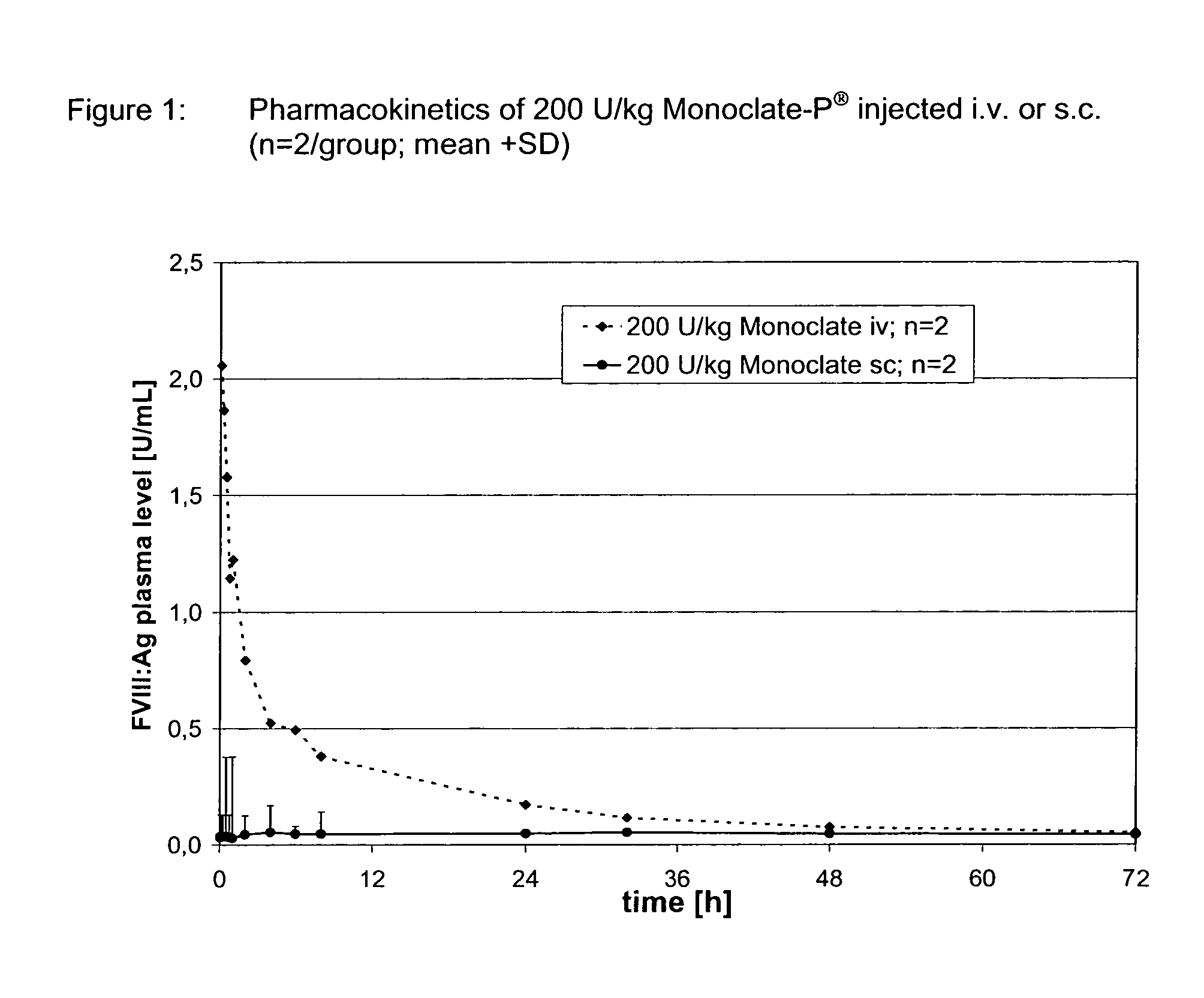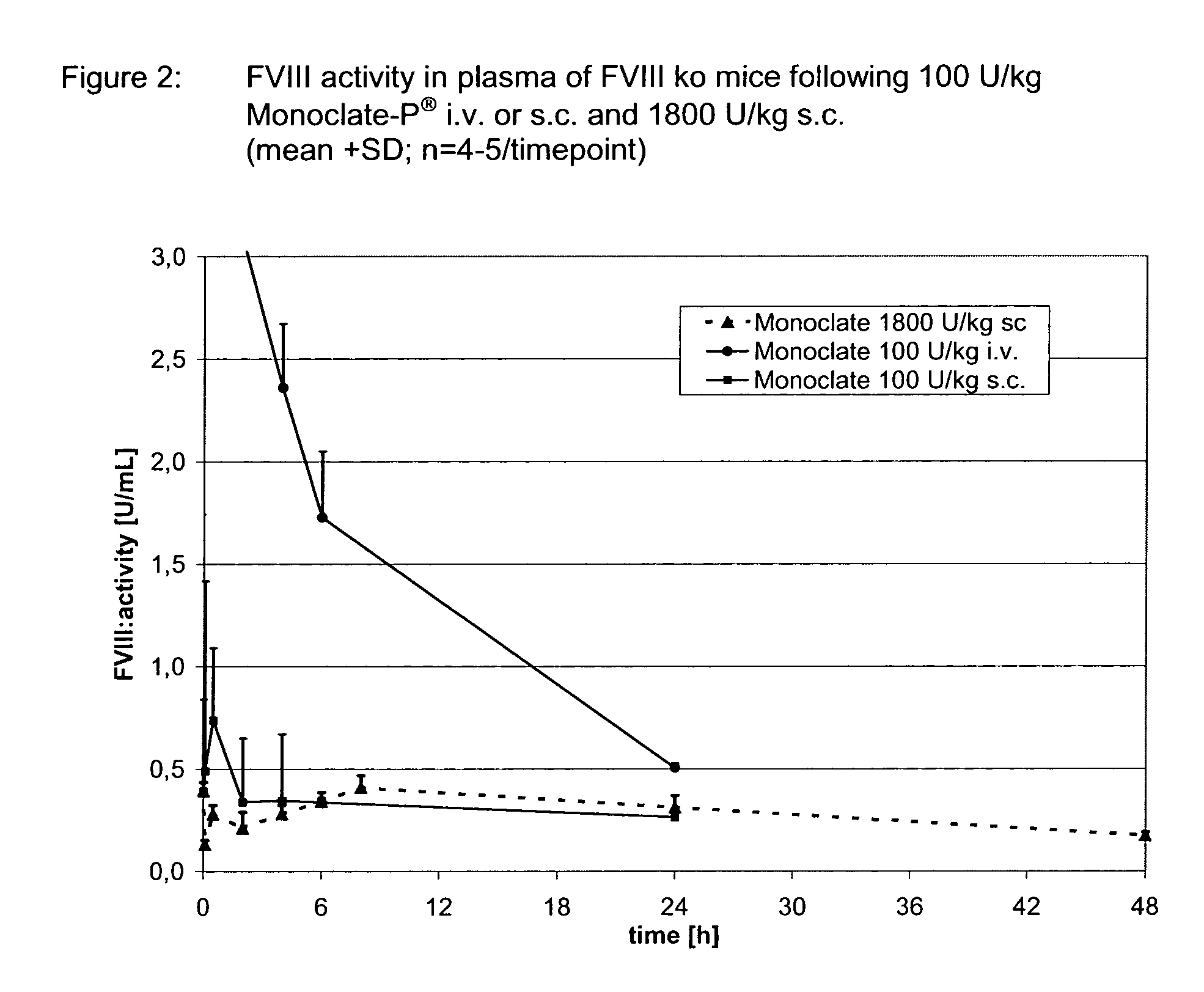Use of VWF stabilized FVIII preparations and of VWF preparations without FVIII for extravascular administration in the therapy and prophylactic treatment of bleeding disorders
a technology of vwf and fviii, which is applied in the direction of extracellular fluid disorder, drug composition, peptide/protein ingredient, etc., can solve the problems of scar formation, increased risk of infection, and difficulty in injecting fviii 3 times per week into the veins of such small patients
- Summary
- Abstract
- Description
- Claims
- Application Information
AI Technical Summary
Benefits of technology
Problems solved by technology
Method used
Image
Examples
example 1
Assessment of Bioavailability of s.c. Applied Monoclate-P® in Rabbits
[0098]200 U / kg of FVIII (Monoclate-P®) was administered via the intravenous (ear vein) route at t=0 or via the subcutaneous (neck) route at t=0 by a single injection to CHB rabbits, weighing about 2.5-3 kg. Blood samples were drawn via the ear vein (contralateral in the case of i.v. injection) for the determination FVIII:Antigen prior to dosing (baseline) and at 5, 15, 30, 45 min., 1, 2, 4, 6, 8 and 24 h (Table 1). The blood was anticoagulated as 10% citrate blood. Human FVIII:Ag was quantified in plasma, processed from blood by centrifugation using a commercial ELISA; Cedarlane Laboratories Ltd. The plasma was stored at −20° C. prior to analysis. FIG. 1 illustrates the poor bioavailability of subcutaneously applied high purity, plasmatic FVIII. Only a minute amount of the s.c. injected FVIII reached the bloodstream. Peak plasma levels reached approximately 0.05 U / mL, which is close to the baseline level of 0.03 U / ...
example 2
Assessment of Bioavailability of s.c. Applied Monoclate-P® in a Hemophilia A Model (FVIII ko Mice)
[0101]Healthy rabbits used as a model to assess the relative bioavailability of Monoclate-P® in example 1 have a physiological, normal level of endogenous FVIII. This circumstance might inhibit the resorption of Monoclate-P® following s.c. injection, resulting in underestimating its relative bioavailability. In addition, an antigen-based approach was required in the rabbit model for a specific quantification allowing a differentiation between the endogenous and the exogenously applied human FVIII. An antigen-based method does however not allow conclusions on the functional activity of the FVIII resorbed.
[0102]To address these issues, FVIII knockout (ko) mice weighing about 25 g were used as a Hemophilia A model. These mice do not express FVIII (Bi L. et al, Nature genetics, 1995, Vol 10(1), 119-121; Bi L. et al, Blood, 1996, Vol 88(9), 3446-3450). This allows the quantification of exper...
example 3
Assessment of Bioavailability of s.c. Administered Haemate® P in a Hemophilia A Model (FVIII ko Mice)
[0105]Surprisingly, when the same dose of FVIII was administered s.c. to FVIII ko mice using a VWF containing product (Haemate® P) a clear rise of FVIII activity in plasma was observed (FIG. 3). Using the same study design and methods as in example 2, the AUDC0-2d was strikingly about 2 higher with Haemate® P as compared to the same dose of Monoclate-P® (Table 3): The peak plasma concentration achieved by Haemate® P was about 2.5 to 3 fold higher, with a maximal difference of up to 10 fold. From this difference, a firm conclusion on the beneficial role of VWF for the resorption of FVIII from the subcutaneous space can be drawn. To further explore the role of VWF the Haemate® P dose was reduced by 50% to 900 U (FVIII:C) / kg in a repeat experiment (Table 4; FIG. 4). Surprisingly this led not to a smaller AUDC0-1d (Table 5). Against the background of this result it appears plausible that...
PUM
| Property | Measurement | Unit |
|---|---|---|
| molecular mass | aaaaa | aaaaa |
| half life | aaaaa | aaaaa |
| concentration | aaaaa | aaaaa |
Abstract
Description
Claims
Application Information
 Login to View More
Login to View More - R&D
- Intellectual Property
- Life Sciences
- Materials
- Tech Scout
- Unparalleled Data Quality
- Higher Quality Content
- 60% Fewer Hallucinations
Browse by: Latest US Patents, China's latest patents, Technical Efficacy Thesaurus, Application Domain, Technology Topic, Popular Technical Reports.
© 2025 PatSnap. All rights reserved.Legal|Privacy policy|Modern Slavery Act Transparency Statement|Sitemap|About US| Contact US: help@patsnap.com



